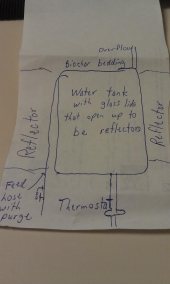
 1
1








Rocket Mag evolution timeline: http://www.permies.com/t/52316/rocket-stoves/Rocket-stove-heats-water-pics
Rocket Mag Thread: http://www.permies.com/t/54074/rocket-stoves/Rocket-Mag-heater-Rocket-Mag
 1
1




 1
1




It's better to keep your mouth shut and appear stupid than open it and remove all doubt - Mark Twain





The other one is a foot in diameter and about 50 inches tall.
Hans Albert Quistorff, LMT projects on permies Hans Massage Qberry Farm magnet therapy gmail hquistorff








Rocket Mag evolution timeline: http://www.permies.com/t/52316/rocket-stoves/Rocket-stove-heats-water-pics
Rocket Mag Thread: http://www.permies.com/t/54074/rocket-stoves/Rocket-Mag-heater-Rocket-Mag












Jake Parkhurst wrote:Scrap that last post if you actually want to use the water as water and not just thermal mass.
Rocket Mag evolution timeline: http://www.permies.com/t/52316/rocket-stoves/Rocket-stove-heats-water-pics
Rocket Mag Thread: http://www.permies.com/t/54074/rocket-stoves/Rocket-Mag-heater-Rocket-Mag




Rocket Mag evolution timeline: http://www.permies.com/t/52316/rocket-stoves/Rocket-stove-heats-water-pics
Rocket Mag Thread: http://www.permies.com/t/54074/rocket-stoves/Rocket-Mag-heater-Rocket-Mag




![Filename: rocketstove.png
Description: The configuration in #4 is closest to what I have in mind [Thumbnail for rocketstove.png]](/t/52991/a/35660/rocketstove.png)





positively optimistic 🙂 https://www.youtube.com/@613Builds
 2
2





Rocket Mag evolution timeline: http://www.permies.com/t/52316/rocket-stoves/Rocket-stove-heats-water-pics
Rocket Mag Thread: http://www.permies.com/t/54074/rocket-stoves/Rocket-Mag-heater-Rocket-Mag
 1
1




 1
1




Rocket Mag evolution timeline: http://www.permies.com/t/52316/rocket-stoves/Rocket-stove-heats-water-pics
Rocket Mag Thread: http://www.permies.com/t/54074/rocket-stoves/Rocket-Mag-heater-Rocket-Mag







positively optimistic 🙂 https://www.youtube.com/@613Builds




 1
1




positively optimistic 🙂 https://www.youtube.com/@613Builds









| I agree. Here's the link: http://stoves2.com |


